
Electric Fuel Pump
Replacing the 50-year-old fuel pump is a great upgrade and it's easier than you think.
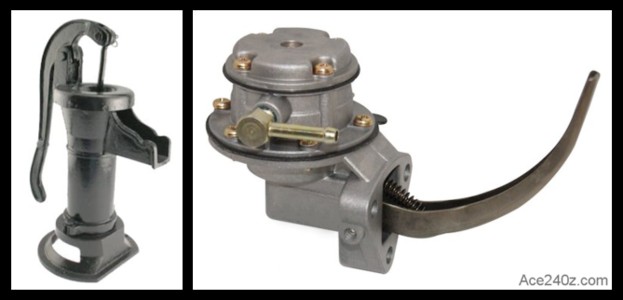 Quite literally, the stock fuel pump is exactly the same as this antique water pump.
Pumping the handle up and down moves a diaphram that creates a vacuum which "pulls" water up to it. Once the water reaches the diaphram, it passes thru a little valve and gets pushed out the spigot and into a bucket.
The fuel pump has a handle that rests on a lobe in the engine. As the engine turns, it moves the handle up and down and "pulls" gasoline from the tank thru 8 feet of tubing and a filter, then into the fuel rail and down into the carbs. The unused fuel goes back into the tank. The faster the engine spins, the faster the pump runs. That was the standard method for nearly a century.
Quite literally, the stock fuel pump is exactly the same as this antique water pump.
Pumping the handle up and down moves a diaphram that creates a vacuum which "pulls" water up to it. Once the water reaches the diaphram, it passes thru a little valve and gets pushed out the spigot and into a bucket.
The fuel pump has a handle that rests on a lobe in the engine. As the engine turns, it moves the handle up and down and "pulls" gasoline from the tank thru 8 feet of tubing and a filter, then into the fuel rail and down into the carbs. The unused fuel goes back into the tank. The faster the engine spins, the faster the pump runs. That was the standard method for nearly a century.
 In the 1990s carmakers began to switch to electric pumps, which are cheaper to make and work more efficiently. They're usually located inside the fuel tank itself. They "push" fuel thru the lines without depending on vacuum and run at a constant speed.
The one shown here is the style typically used for Z cars because it's the same one Datsun used for the 260z and 280z. They used a higher-pressure version for the 280z because of the fuel injection system.
There are several manufacturers for this type but they're all the same design. I bought a generic no-name version for about $80, which is about twice the cost of the mechanical type but I think it's worth the higher price.
In the 1990s carmakers began to switch to electric pumps, which are cheaper to make and work more efficiently. They're usually located inside the fuel tank itself. They "push" fuel thru the lines without depending on vacuum and run at a constant speed.
The one shown here is the style typically used for Z cars because it's the same one Datsun used for the 260z and 280z. They used a higher-pressure version for the 280z because of the fuel injection system.
There are several manufacturers for this type but they're all the same design. I bought a generic no-name version for about $80, which is about twice the cost of the mechanical type but I think it's worth the higher price.
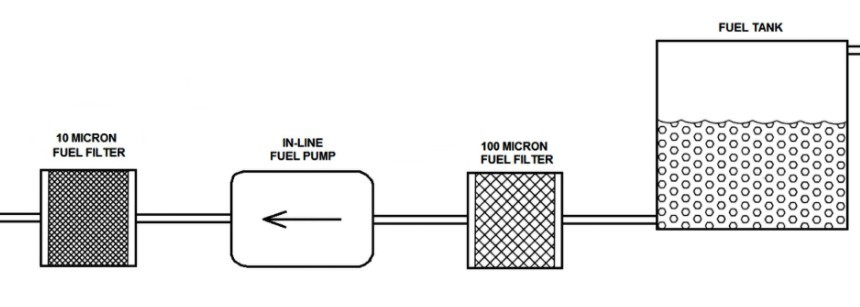 This diagram is from Holley Carburetors and shows how an electric pump and filters should be connected.
A typical electric pump has a filter built inside but it's not a bad idea to have a filter between it and the tank. However, that filter needs to be somewhat free-flowing to prevent any fuel starvation.
On the output side you can use a finer grade filter, such as the one typically used on a Z. With this setup, you're literally getting triple protection before any gas reaches the carbs.
This diagram is from Holley Carburetors and shows how an electric pump and filters should be connected.
A typical electric pump has a filter built inside but it's not a bad idea to have a filter between it and the tank. However, that filter needs to be somewhat free-flowing to prevent any fuel starvation.
On the output side you can use a finer grade filter, such as the one typically used on a Z. With this setup, you're literally getting triple protection before any gas reaches the carbs.
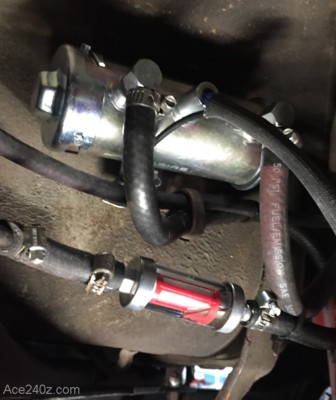 Here's how mine turned out.
It's bolted to the spare tire well, as high up as possible to keep it away from any dirt or debris. It came with rubber isolators to reduce any sound or vibration. I drilled two holes inside the well and used nylock nuts to holt it in place. It's a snug fit.
In the stock layout, there's a rubber hose that goes from the tank to a steel line running forward to the mechanical pump. I replaced that with a short piece of hose from the tank to the filter, and then to the input side of the the pump, and from the output to the steel line. I used top-quality hose and clamps, then tied it all together with a couple of zip-ties.
The pump requires 12 volts. When I did the new wiring for my car, I ran a few extra wires to the rear and now was able to use one of them for the pump. Because it requires so little power, you can run a wire from the fuse block beneath the carpet and to the back. Choose a circuit that is only "hot" when the ignition is turned on.
With the key on, the pump makes a slight humming sound but it can't be heard when the engine is running.
Here's how mine turned out.
It's bolted to the spare tire well, as high up as possible to keep it away from any dirt or debris. It came with rubber isolators to reduce any sound or vibration. I drilled two holes inside the well and used nylock nuts to holt it in place. It's a snug fit.
In the stock layout, there's a rubber hose that goes from the tank to a steel line running forward to the mechanical pump. I replaced that with a short piece of hose from the tank to the filter, and then to the input side of the the pump, and from the output to the steel line. I used top-quality hose and clamps, then tied it all together with a couple of zip-ties.
The pump requires 12 volts. When I did the new wiring for my car, I ran a few extra wires to the rear and now was able to use one of them for the pump. Because it requires so little power, you can run a wire from the fuse block beneath the carpet and to the back. Choose a circuit that is only "hot" when the ignition is turned on.
With the key on, the pump makes a slight humming sound but it can't be heard when the engine is running.
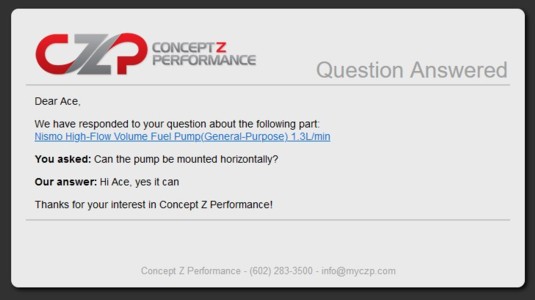 When Datsun began using this type of pump, they oriented it vertically, which might have been done for ease of assembly. For me, mounting it horizontally worked best.
After getting some criticism from various people who insisted it needed to be vertical, I contacted several manufacturers and they all said it didn't matter.
When Datsun began using this type of pump, they oriented it vertically, which might have been done for ease of assembly. For me, mounting it horizontally worked best.
After getting some criticism from various people who insisted it needed to be vertical, I contacted several manufacturers and they all said it didn't matter.
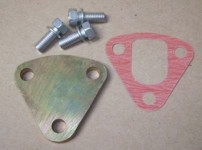 The last thing is to remove the mechanical pump and cover the hole. You can buy a premade plate like this but if you have a hacksaw and a drill it's easy enough to make one yourself and save a few bucks.
The last thing is to remove the mechanical pump and cover the hole. You can buy a premade plate like this but if you have a hacksaw and a drill it's easy enough to make one yourself and save a few bucks.